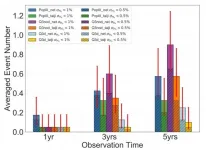(Press-News.org) UC San Francisco researchers have found a way to double doctors' accuracy in detecting the vast majority of complex fetal heart defects in utero - when interventions could either correct them or greatly improve a child's chance of survival - by combining routine ultrasound imaging with machine-learning computer tools.
The team, led by UCSF cardiologist Rima Arnaout, MD, trained a group of machine-learning models to mimic the tasks that clinicians follow in diagnosing complex congenital heart disease (CHD). Worldwide, humans detect as few as 30 to 50 percent of these conditions before birth. However, the combination of human-performed ultrasound and machine analysis allowed the researchers to detect 95% of CHD in their test dataset.
The findings appear in the May issue of Nature Medicine.
Fetal ultrasound screening is universally recommended during the second trimester of pregnancy in the United States and by the World Health Organization. Diagnosis of fetal heart defects, in particular, can improve newborn outcomes and enable further research on in utero therapies, the researchers said.
"Second-trimester screening is a rite of passage in pregnancy to tell if the fetus is a boy or girl, but it is also used to screen for birth defects," said Arnaout, a UCSF assistant professor and lead author of the paper. Typically, the imaging includes five cardiac views that could allow clinicians to diagnosis up to 90 percent of congenital heart disease, but in practice, only about half of those are detected at non-expert centers.
"On the one hand, heart defects are the most common kind of birth defect, and it's very important to diagnose them before birth," Arnaout said. "On the other hand, they are still rare enough that detecting them is difficult even for trained clinicians, unless they are highly sub-specialized. And all too often, in clinics and hospitals worldwide, sensitivity and specificity can be quite low."
The UCSF team, which included fetal cardiologist and senior author Anita Moon-Grady, MD, trained the machine tools to mimic clinicians' work in three steps. First, they utilized neural networks to find five views of the heart that are important for diagnosis. Then, they again used neural networks to decide whether each of these views was normal or not. Then, a third algorithm combined the results of the first two steps to give a final result of whether the fetal heart was normal or abnormal.
"We hope this work will revolutionize screening for these birth defects," said Arnaout, a member of the UCSF Bakar Computational Health Sciences Institute, the UCSF Center for Intelligent Imaging, and a Chan Zuckerberg Biohub Intercampus Research Award Investigator. "Our goal is to help forge a path toward using machine learning to solve diagnostic challenges for the many diseases where ultrasound is used in screening and diagnosis."
INFORMATION:
Co-authors include Lara Curran, MBBS; Yili Zhao, PhD, and Erin Chinn, MS, from UCSF; and Jami Levine from Boston Children's Hospital. The project was supported by the UCSF Academic Research Systems, National Institutes of Health (UL1 TR991872 and R01HL150394), the American Heart Association and the Department of Defense. Please see the paper for additional authors, funding details, and disclosures.
About UCSF Health: UCSF Health is recognized worldwide for its innovative patient care, reflecting the latest medical knowledge, advanced technologies and pioneering research. It includes the flagship UCSF Medical Center, which is ranked among the top 10 hospitals nationwide, as well as UCSF Benioff Children's Hospitals, with campuses in San Francisco and Oakland, Langley Porter Psychiatric Hospital and Clinics, UCSF Benioff Children's Physicians and the UCSF Faculty Practice. These hospitals serve as the academic medical center of the University of California, San Francisco, which is world-renowned for its graduate-level health sciences education and biomedical research. UCSF Health has affiliations with hospitals and health organizations throughout the Bay Area. Visit http://www.ucsfhealth.org/. Follow UCSF Health on Facebook or on Twitter.
Follow UCSF
ucsf.edu | Facebook.com/ucsf | Twitter.com/ucsf | YouTube.com/ucsf
University of Virginia School of Medicine scientists have developed important new resources that will aid the battle against cancer and advance cutting-edge genomics research.
UVA's Chongzhi Zang, PhD, and his colleagues and students have developed a new computational method to map the folding patterns of our chromosomes in three dimensions from experimental data. This is important because the configuration of genetic material inside our chromosomes actually affects how our genes work. In cancer, that configuration can go wrong, so scientists want to understand ...
Hundreds of antibiotic resistant genes found in the gastrointestinal tracts of Danish infants
Danish one-year-olds carry several hundred antibiotic resistant genes in their bacterial gut flora according to a new study from the University of Copenhagen. The presence of these genes is partly attributable to antibiotic use among mothers during pregnancy.
An estimated 700,000 people die every year from antibiotic resistant bacterial infections and diseases. The WHO expects this figure to multiply greatly in coming decades. To study how antibiotic resistance occurs in humans' ...
The Hubble parameter is one of the central parameters in the modern cosmology. Their values inferred from the late-time observations are systematically higher than those from the early-time measurements by about 10%. This is called the "Hubble tension". To come to a robust conclusion, independent probes with accuracy at percent levels are crucial. With the self-calibration by the theory of general relativity, gravitational waves from compact binary coalescence open a completely novel observational window for Hubble parameter determination. Hence, it can shed some light on the Hubble tension. Depends on whether being associated with ...
A new rapid coronavirus test developed by KAUST scientists can deliver highly accurate results in less than 15 minutes.
The diagnostic, which brings together electrochemical biosensors with engineered protein constructs, allows clinicians to quickly detect bits of the virus with a precision previously only possible with slower genetic techniques. The entire set-up can work at the point of patient care on unprocessed blood or saliva samples; no laborious sample preparation or centralized diagnostic laboratory is required.
"The combination of state-of-the-art ...
Dust storms are often defined as catastrophic weather events where large amounts of dust particles are raised and transported by strong winds, characterized by weak horizontal visibility (< 1 km), suddenness, short duration, and severe destruction. Over the past few decades, the observed dust storms in northern China showed generally decreasing trends (Fig. 2), which could have made the dust storms "out of sight" of the public gradually. Yet a most recent strong dust storm event originated from Mongolia since mid-March this year exerted serious impacts on most areas in northern China, ...
RICHLAND, Wash.--As the Clean Energy Transformation Act drives Washington state toward carbon-free electricity, a new energy landscape is taking shape. Alongside renewable energy sources, a new report finds small modular reactors are poised to play an integral role in the state's emerging clean energy future.
The technology could help fill a power source gap soon to be left by carbon-emitting resources like coal and natural gas, which will be phased out in coming years, according to a report composed by researchers at the U.S. Department of Energy's Pacific Northwest National Laboratory and Massachusetts Institute of Technology.
"Nuclear energy is a reliable source of baseload electricity," said PNNL's ...
Modern genetic research often works with what are known as reference genomes. Such a genome comprises data from DNA sequences that scientists have assembled as a representative example of the genetic makeup of a species.
To create the reference genome, researchers generally use DNA sequences from a single or a few individuals, which can poorly represent the complete genomic diversity of individuals or sub-populations. The result is that a reference does not always correspond exactly to the set of genes of a specific individual.
Until a few years ago, it was very laborious, expensive and time-consuming to generate ...
Many eye diseases are associated with a restricted blood supply, known as ischaemia, which can lead to blindness. The role of the protein tenascin-C, an extracellular matrix component, in retinal ischaemia was investigated in mice by researchers from Ruhr-Universität Bochum (RUB). They showed that tenascin-C plays a crucial role in damaging the cells responsible for vision following ischaemia. The results were published online by the team in the journal Frontiers in Neuroscience on 20 May 2021.
As part of the research, the team around Dr. Susanne Wiemann and Dr. Jacqueline Reinhard from the Department of Cell Morphology and Molecular Neurobiology at RUB collaborated with Professor Stephanie Joachim's research group from ...
Included in the vast fallout stemming from the COVID-19 pandemic, scientists are paying closer attention to microbial infections and how life forms defend against attacks from pathogens.
Research led by University of California San Diego scientists has shed new light on the complex dynamics involved in how organisms sense that an infection is taking place.
UC San Diego Assistant Project Scientist Eillen Tecle in Professor Emily Troemel's laboratory (Division of Biological Sciences) led research focusing on how cells that are not part of the conventional immune system respond to infections when pathogens attack. Scientists have conducted extensive research on so-called "professional" immune cells that are defensive specialists. Much less is known about how "non-professional" cells ...
Alzheimer's disease - also called dementia - where memory and cognitive functions gradually decline due to deformation and death of neurons, and Parkinson's disease that causes tremors in hands and arms impeding normal movement are major neurodegenerative diseases. Recently, a research team at POSTECH has identified the structure of the agent that causes Alzheimer's and Parkinson's diseases to occur together.
A research team led by Professor Joon Won Park and Ph.D. candidate Eun Ji Shin of the Department of Chemistry at POSTECH investigated the surface structure of hetero-oligomers found in the overlap of Alzheimer's disease and Parkinson's disease, using an atomic force microscopy (AFM) to reveal their structural identity. This study was featured as the ...






